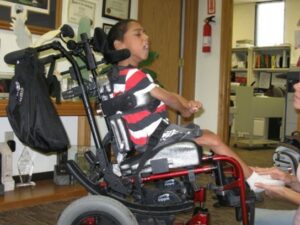General Seating Strategies used with People who have Increased Muscle Tone
Michelle L. Lange, OTR/L, ABDA, ATP/SMS
This blog is part 6 of a series on Muscle Tone. In this blog, we will discuss general wheelchair seating strategies commonly used when working with someone who has increased muscle tone.
We have many resources on determining the best seating solutions for people using wheelchairs. Texts, articles, courses, and webinars are all useful tools. If you learn best by reading, I highly recommend Seating and Wheeled Mobility: a clinical resource guide by Slack. If you learn best by attending in-person courses, I absolutely recommend the International Seating Symposium.
In this brief overview, we will discuss general seating strategies by body area. Assessment should include a mat evaluation to determine causes for each positioning challenge before solutions are explored.
A person with increased muscle tone will often display a posterior tilt, often in combination with pelvic rotation and/or obliquity. To achieve and maintain a neutral tilt, it is important to have adequate support both posterior to the pelvis (the back) and under the pelvis (the seat). A biangular back shape is often used to keep the pelvis upright and allow some trunk extension. The seating surface may include a shape that prevents the ischial tuberosities (ITs) from rotating forward and is used in combination with an appropriately angled pelvic belt – typically at 60 degrees. If limited range of motion is causing posterior pelvic tilt, the seating angles must respect these limitations.
A common pattern seen in people with increased muscle tone is hip, knee, and ankle extension in combination with hip adduction and internal rotation. In general, building in flexion and abduction can ‘break’ up this pattern.
Pelvic rotation can usually be corrected, but range of motion limitations at the hip may lead to a windswept posture of the legs, as a result. In this case, we allow the legs to be asymmetrical in order to keep the pelvis in neutral alignment. Sometimes, all that is required is to mount the pelvic belt so that this pulls back on the forward side of the pelvis.
Pelvic obliquity strategies vary whether the obliquity is reducible or not. If the obliquity is reducible, a pelvic belt placed at 90 degrees (or over the lap) may be adequate to level the pelvis out. If not, a wedge can be placed under the cushion beneath the low side of the pelvis. If the obliquity is not reducible, a wedge can be placed under the cushion beneath the high side of the pelvis in an effort to better distribute pressure under each IT.
The Trunk
People with increased tone may display kyphosis, lateral scoliosis, or trunk rotation. Kyphosis, or forward trunk flexion, requires both posterior and anterior support. The same back shape used to control a posterior pelvic tilt is also helpful in addressing trunk flexion. A wide variety of anterior trunk supports such as chest straps, shoulder straps, and vests are available. Trunk rotation can typically be controlled through anterior and posterior trunk supports, as well. Lateral trunk flexion, when reducible, can also be addressed with force and counterforce. This is typically achieved by use of lateral trunk supports, sometimes in combination with lateral pelvic supports.
The Lower Extremities
 A common pattern seen in people with increased muscle tone is hip, knee, and ankle extension in combination with hip adduction and internal rotation. In general, building in flexion and abduction can ‘break’ up this pattern. The same strategies we discussed to address a posterior pelvic tilt can ensure hip flexion. Knee and ankle flexion are often provided by securing the feet to the foot plates, such as using ankle and toe straps or shoe holders. Hip adduction and internal rotation can be addressed through either the use of a contoured seat or a medial knee support. A medial knee support is NOT designed to keep the pelvis back, but to keep the knees apart and in alignment with the hips. It is important to respect lower extremity range limitations within the seating system, as well.
A common pattern seen in people with increased muscle tone is hip, knee, and ankle extension in combination with hip adduction and internal rotation. In general, building in flexion and abduction can ‘break’ up this pattern. The same strategies we discussed to address a posterior pelvic tilt can ensure hip flexion. Knee and ankle flexion are often provided by securing the feet to the foot plates, such as using ankle and toe straps or shoe holders. Hip adduction and internal rotation can be addressed through either the use of a contoured seat or a medial knee support. A medial knee support is NOT designed to keep the pelvis back, but to keep the knees apart and in alignment with the hips. It is important to respect lower extremity range limitations within the seating system, as well.
The Head
Many people with increased tone in their extremities may have low tone in the trunk and neck. As a result, we often see someone with poor head control and poor head position. Providing appropriate head support as well as overall body positioning to optimize head control is key. The position of the head is extremely dependent on the position of the pelvis and trunk. Using gravity to facilitate an upright head can be achieved by opening the seat to back angle or using tilt.
Wheelchair positioning can be used to inhibit muscle tone and active extension. In our last blog in this series, we will discuss how Dynamic Seating can be used in conjunction with these strategies to achieve and maintain an optimal position in these circumstances.
For more information, check out our CEU course on this topic here!
